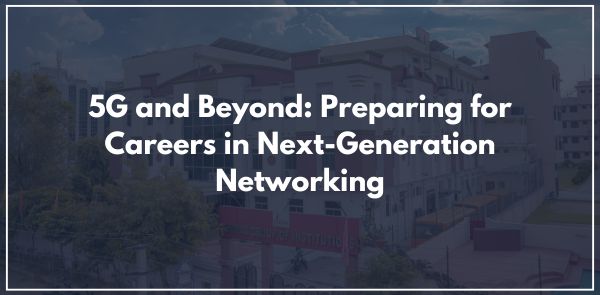The advent of 5G technology marks a significant leap forward in the world of telecommunications, promising to revolutionize not only mobile communications but also the broader spectrum of connectivity in various sectors. As we move beyond 5G, new technologies and innovations are emerging, further transforming how we connect, communicate, and interact with the digital world. For aspiring tech professionals, understanding and preparing for careers in next-generation networking is essential to capitalize on the opportunities this evolution presents. This article explores the landscape of 5G and beyond, highlighting key technologies, industry impacts, and the skills needed for a successful career in this dynamic field.
Understanding 5G and Its Impact
What is 5G?
5G, or the fifth generation of wireless technology, offers unprecedented speed, reduced latency, and enhanced connectivity compared to its predecessors. Key features of 5G include:
- Ultra-Fast Speeds: Capable of delivering data rates up to 10 Gbps, significantly faster than 4G.
- Low Latency: Latency as low as 1 millisecond, enabling real-time applications.
- Massive Device Connectivity: Supports up to a million devices per square kilometer, ideal for IoT applications.
- Improved Reliability: Enhanced network reliability and stability for critical applications.
Impact on Industries
The impact of 5G extends across various industries, driving innovation and enabling new applications:
- Healthcare: Telemedicine, remote surgery, and real-time patient monitoring become more feasible and effective.
- Automotive: Autonomous vehicles and smart transportation systems rely on fast, reliable communication.
- Manufacturing: Industrial IoT and smart factories enhance production efficiency and flexibility.
- Entertainment: Enhanced AR/VR experiences, cloud gaming, and high-definition streaming.
- Smart Cities: Improved infrastructure management, public safety, and environmental monitoring through connected devices.
Beyond 5G: The Future of Connectivity
6G and Emerging Technologies
As we look beyond 5G, the development of 6G and other emerging technologies promises even greater advancements:
-
Terahertz Communication: Utilizing higher frequency bands to achieve even faster data rates and lower latency.
- AI-Driven Networks: Artificial intelligence and machine learning to optimize network performance and manage complexity.
- Quantum Communication: Leveraging quantum mechanics for ultra-secure communication and improved data processing capabilities.
- Satellite Internet: Expanding global connectivity through low-Earth orbit (LEO) satellites, enabling high-speed internet access in remote areas.
Potential Applications
The potential applications of 6G and beyond are vast, encompassing areas such as holographic communication, enhanced AI interaction, and ubiquitous connectivity, further transforming how we live and work.
Preparing for Careers in Next-Generation Networking
Essential Skills and Knowledge
To thrive in the field of next-generation networking, aspiring professionals need a combination of technical expertise and soft skills:
- Technical Proficiency
- Networking Fundamentals: Understanding of basic networking concepts, protocols, and architectures.
- Wireless Communication: Knowledge of wireless technologies, including 4G, 5G, and emerging 6G concepts.
- Programming and Scripting: Proficiency in programming languages (Python, C++) and scripting (Bash, Perl) for network automation and management.
- Cybersecurity: Understanding of security principles and practices to protect network infrastructure.
- Advanced Technologies
- Cloud Computing: Familiarity with cloud platforms (AWS, Azure) and their integration with network services.
- IoT: Knowledge of IoT devices, protocols, and their applications in various industries.
- AI and Machine Learning: Understanding of AI/ML concepts and their application in network optimization and management.
- Soft Skills
- Problem-Solving: Ability to troubleshoot and resolve complex networking issues.
- Communication: Effective communication skills to collaborate with cross-functional teams and explain technical concepts to non-technical stakeholders.
- Adaptability: Willingness to learn and adapt to rapidly evolving technologies and industry trends.
Educational Pathways
A solid educational foundation is crucial for a career in next-generation networking:
- Degree Programs: A bachelor's degree in computer science, information technology, or electrical engineering is often required. Advanced positions may require a master's degree or Ph.D. in related fields.
- Certifications: Industry-recognized certifications, such as Cisco’s CCNA, CCNP, and CCIE, CompTIA Network+, and 5G-specific certifications, can enhance career prospects and demonstrate expertise.
- Online Courses and Bootcamps: Various online platforms offer specialized courses and bootcamps in networking, 5G technology, and related fields, providing flexible learning opportunities.
Practical experience is invaluable in this field:
- Internships: Seek internships with telecom companies, network service providers, or tech firms to gain hands-on experience.
- Projects: Engage in personal or academic projects related to networking, such as setting up a home lab, participating in hackathons, or contributing to open-source projects.
- Networking and Mentorship: Join professional organizations, attend industry conferences, and seek mentorship from experienced professionals to build a network and gain insights into the industry.
Conclusion
The transition to 5G and the development of next-generation networking technologies herald a new era of connectivity, with far-reaching implications for various industries and everyday life. For aspiring tech professionals, this evolution presents a wealth of career opportunities. By acquiring the necessary technical skills, pursuing relevant education and certifications, and gaining practical experience, individuals can position themselves at the forefront of this exciting and dynamic field. Embracing the future of connectivity means not only staying updated with technological advancements but also contributing to the innovations that will shape our digital landscape for years to come.
